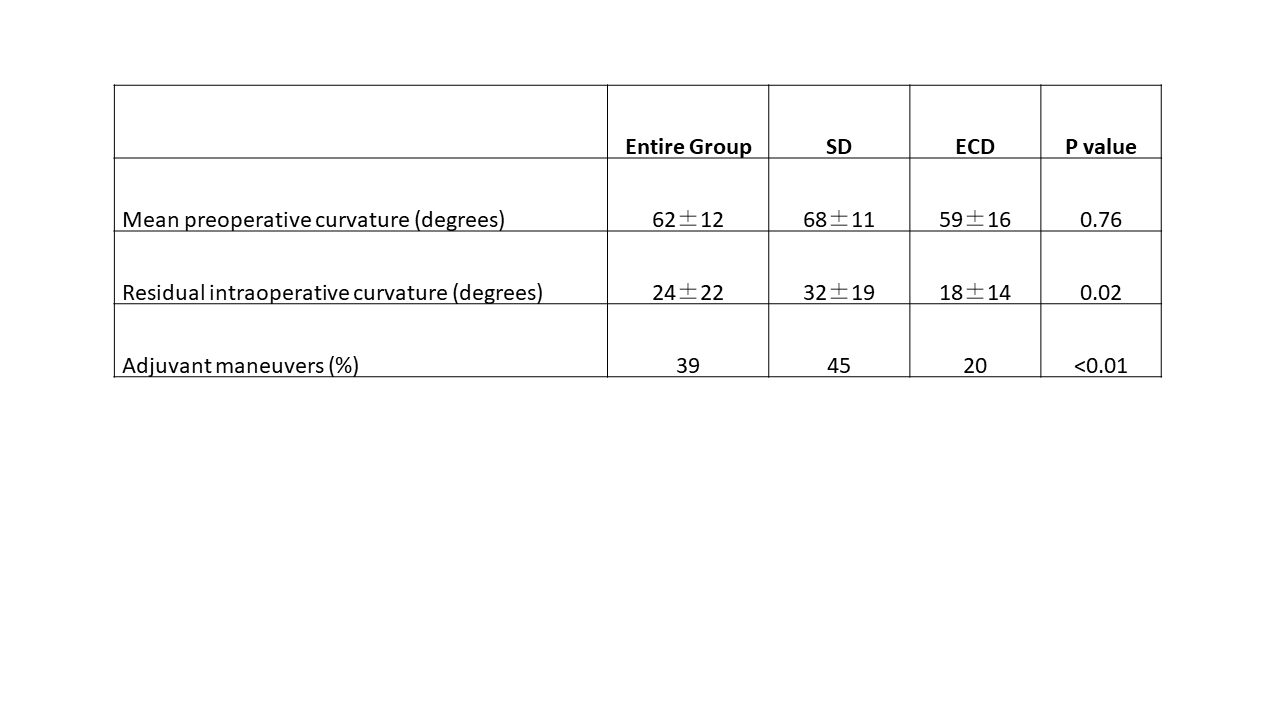Back
Poster, Podium & Video Sessions
Podium
PD52: Sexual Function/Dysfunction: Surgical Therapy II
PD52-02: Extended Corporal Dilation (ECD) of Men with Peyronie's Disease (PD) at the Time of Inflatable Penile Implant Surgery (IPP)
Monday, May 16, 2022
7:10 AM – 7:20 AM
Location: Room 252
Hisanori Taniguchi*, Jose Flores, Carolyn Salter, Helen Bernie, John Mulhall, New York, NY
- HT
Podium Presenter(s)
Introduction: Intraoperative residual curvature after placement of an IPP is a recognized occurrence, the likelihood being related to the magnitude of curvature prior to the implant surgery. While the correction of penile curvature by IPP surgery is likely through multiple mechanisms, it is certain it is not solely the result of plaque stretching and likely involves disruption of collagenized intracorporal struts. We undertook an analysis of patients who underwent ECD intraoperatively to define its impact on the need for adjuvant intraoperative maneuvers (modeling, plaque incision, tunical grafting).
Methods: The study population consisted of (i) men with PD (ii) who underwent 3-piece IPP surgery (iii) and underwent penile duplex Doppler ultrasound with curvature assessment (iv) with at least 80% rigidity achieved during the study and (v) goniometer assessment of deformity magnitude. Prior to 2016, corporal standard dilation (SD) with a Dilamezinsert and obturator was conducted. Since 2016, we have pursued ECD adding the use of serial Hegar dilators with at least 14mm dilation following the standard dilation. After device insertion and full inflation, repeat goniometer assessment of residual curvature was performed. If >20 degrees of curvature remained adjuvant maneuvers were performed. We compared residual curvature rates and the need for adjuvant intraoperative maneuvers between SD and ECD groups.
Results: We have complete data on 284 men who had IPP surgery in the presence PD. Mean age = 63 ± 22 years. All 218 (77%) patients had SD, 66 (23%) ECD. Baseline and residual curvature for the entire group was 62±12 and 24±22 degrees. The table illustrates that despite similar baseline magnitude of penile curvature (p=0.76), ECD resulted in less post-implant intraoperative residual curvature (p=0.02) and less need for intraoperative adjuvant maneuvers (p= <0.01). 1 patient in each group had an intraoperative urethral perforation duration dilation (SD <1%, ECD 1.5%; p <0.05).
Conclusions: Extended corporal dilation results in less residual curvature at the time of IPP and less need for adjuvant maneuvers. This has become our standard approach to dilation in men with PD undergoing IPP surgery.
Source of Funding: none

Methods: The study population consisted of (i) men with PD (ii) who underwent 3-piece IPP surgery (iii) and underwent penile duplex Doppler ultrasound with curvature assessment (iv) with at least 80% rigidity achieved during the study and (v) goniometer assessment of deformity magnitude. Prior to 2016, corporal standard dilation (SD) with a Dilamezinsert and obturator was conducted. Since 2016, we have pursued ECD adding the use of serial Hegar dilators with at least 14mm dilation following the standard dilation. After device insertion and full inflation, repeat goniometer assessment of residual curvature was performed. If >20 degrees of curvature remained adjuvant maneuvers were performed. We compared residual curvature rates and the need for adjuvant intraoperative maneuvers between SD and ECD groups.
Results: We have complete data on 284 men who had IPP surgery in the presence PD. Mean age = 63 ± 22 years. All 218 (77%) patients had SD, 66 (23%) ECD. Baseline and residual curvature for the entire group was 62±12 and 24±22 degrees. The table illustrates that despite similar baseline magnitude of penile curvature (p=0.76), ECD resulted in less post-implant intraoperative residual curvature (p=0.02) and less need for intraoperative adjuvant maneuvers (p= <0.01). 1 patient in each group had an intraoperative urethral perforation duration dilation (SD <1%, ECD 1.5%; p <0.05).
Conclusions: Extended corporal dilation results in less residual curvature at the time of IPP and less need for adjuvant maneuvers. This has become our standard approach to dilation in men with PD undergoing IPP surgery.
Source of Funding: none


.jpg)
.jpg)